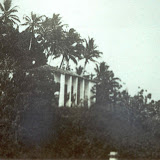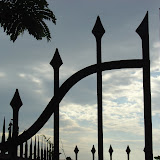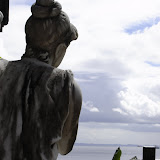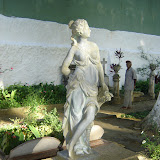Thursday, March 17, 2011
BBC Audio Slideshow on Highgate Cemetery
Saturday, September 18, 2010
New photos of the British Cemetery by Pedro Muniz
Tuesday, July 07, 2009
Facing the Blue
By Tatiana Mendonça
Translated by H. Sabrina Gledhill
The expression goes “for the English to see.”* In this case, their dead have one of the best views of the bay. The fact that they can’t enjoy it is a mere detail. But anyone can share the peace and quiet that reigns supreme in the
But it hasn’t always been this way. There was a time when the jungle had taken over this place and thieves jumped over the fragile wall to hide their loot. It was back then, in 2004, that Sabrina Gledhill, a British researcher, came across the cemetery. She was working in the chapel with children from the Ibeji NGO. The social project is no more, but her interest in this place persisted.
Sabrina took part in the development of a revitalization project that gained the support of FazCultura (the state tax incentive program for cultural projects) and the Clemente Mariani Foundation. And then there was light. In February of last year, the cemetery founded in 1811 was reopened in the presence of the British Ambassador in
The
DOCTORS AND SLAVE TRADERS
The cemetery is located in one of the finest parts of the city and is the resting place of some 500 people. “It is hard to say exactly how many, because many of the tombstones have disappeared,” says Sabrina. The records show that two sailors from the Beagle, which brought
One of the tombs that is still in its original place is that of John Ligertwood Paterson, MD. A pioneer in the fight against cholera and yellow fever, he helped found the
The first person buried in this place was John Sharp, a slave trader who died in 1813. His tomb lies in the shadow of a tree, the stone covered in moss.
But it isn’t just Britons who are buried here. A Bahian woman, Maria Constância Ogilvie, the wife of a British merchant, is also there. After she died, her husband returned to
The
*(Translator’s note: A Brazilian expression meaning “whitewash” or “sham” – the author is using it literally in this case.)
Article published in Muito magazine by the A Tarde newspaper on 5th July 2009
Tuesday, February 24, 2009
Darwin in Bahia programme launch
 |
| Darwin Launch/Lançamento |
Saturday, November 22, 2008
Tuesday, November 18, 2008
Saturday, October 18, 2008
Symposium on British Presence in Bahia

INTERNATIONAL SYMPOSIUM ON DIPLOMACY, ECONOMICS AND CULTURE: THE HISTORY OF THE BRITISH PRESENCE IN BAHIA - 3rd to 8th November 2008
This cultural event is being promoted by the St. George’s Society and has the support and approval of the British Embassy, is in receipt of funding from FAPESB and is being hosted by the Centro de Memória da Bahia, Fundação Pedro Calmon from 3 to 7 November.
Participation is free of charge; however, places are limited. If you are interested in participating, please contact Sabrina Gledhill at britanicosnabahia@gmail.com to reserve your place.
From 3 to 7 Nov, the programme will be in Portuguese at the auditorium of the Central Library in Barris. On the 8th, a special event will be held at the British Cemetery Chapel, where the presentations that were translated during the main event will be given once again in English, without translation:
Marc Herold - "The British Contribution to Bahia"
Louise Guenther - "The British Merchant Community in Bahia in the 19th century"
John Vignoles - "Charles Blacker Vignoles and Hutton Vignoles: The British engineers who built the Bahia and São Francisco Railway"
For further information on the Symposium (in Portuguese) visit britanicosnabahia.blogspot.com
Thursday, June 12, 2008
Brazilian Supreme Court rules in favour of British Cemetery

On May 21st, the Brazilian Supreme Court ruled that cemeteries that are extensions of religious entities, operate on a non-profit basis and are exclusively devoted to religious and funerary services are exempt from property tax (IPTU).
This decision was reached unanimously when judging an appeal lodged by the St. George's Church and British Cemetery Society of Salvador, Bahia, and the Anglican Church, contesting the decision of the Bahian Court, which did not recognise that the area where the cemetery is located is exempt from property tax. The Bahian treasury was threatening to auction off the historic cemetery to pay off a debt of BRL 41,831.70 (over 10,000 pounds) for the period between 1994 and 1996.
Heritage site
Situated in one of the finest districts of Salvador, Bahia (Ladeira da Barra), the Anglican chapel and cemetery were built 200 years ago by Britons who accompanied the Portuguese royal family when they arrived in Brazil in 1808.
According to the defence, the future King João VI of Portugal signed the free navigation treaty with the British goverment in the chapel (demolished in the 1970s), thereby ensuring that Anglican British subjects resident in Salvador had the right to worship and bury their dead.
The cemetery has been listed as a heritage site at the state level and is in the process of being listed at the federal level by the Ministry of Culture's National Institute for Historic and Artistic Heritage.
For more background information click here
The British Church and Cemetery at Salvador are owned and administered by the "SOCIEDADE DA IGREJA DE SÃO JORGE E CEMITERIO BRITANICO" (a non-profit organisation), representing the British community in Bahia.
Monday, March 03, 2008
Taxing the Dead
Yesterday (02/03/08), on p. 13 of its Sunday issue, the newspaper A Tarde published an article by Mary Weinstein, titled:
Here are two excerpts:
"The British Cemetery on Ladeira da Barra, founded after the Brazilian ports were opened to 'friendly nations' in 1808 by [the future] João VI of Portugal, owes roughly BRL 1 million in property tax (IPTU). That total is estimated by the [retired] honorary British consul, Nigel Lee, based on five tax foreclosures issued in the last 15 years by the Treasury Department. He knows that, according to the notifications received, 'the property could be auctioned off' if that debt is not paid."
"For the past two years, the British Cemetery, which is about 3,200 sq.m in area, has been undergoing a process of restoration to ensure that its historic and aesthetic value is preserved.... It contains monumental tombstones, tablets and sculptures dating from the 19th and 20th centuries that comprise part of the State of Bahia's cemetery art collection, as well as being a listed heritage site. The guest book for the cemetery, which is now an open-air museum, shows that visitors from several countries have displayed interest in this historic cemetery. To go in, all you need to do is ring the bell that hangs by the front gate".
Tuesday, February 26, 2008
Scenes from the Rededication Ceremony
 |
| Rededicati |
Click on the photo to see the slideshow
Rededication of the British Cemetery
Monday, April 09, 2007
Thursday, April 05, 2007
Saturday, July 29, 2006
British Presence project shortlisted
Sunday, April 23, 2006
Message from the St. George's Church and British Cemetery Society
For a great number of years the Society was unable to protect the cemetery and carry out the necessary maintenance work due to lack of funds, with the result that the cemetery was much damaged by the action of weather and vandals. However, the cemetery had become the focus of the society’s concerns since the value of the institution as a historical site reflecting early British interests in Bahia was recognised, as well as due respect for the fundamental concept of ensuring that the last resting place of those buried there should continue as a place of dignity, respect, and beauty.
To obtain some measure of protection, the Society had petitioned the State Government to declare the cemetery a site of historical interest and this status was eventually granted in September of 1993 by State law No. 2457.
In March 2003, architect Ernesto Carvalho presented a detailed project for the restoration of the cemetery, but implementation was postponed due to the absence of funding.
April 2003 saw the signing of an agreement between the Society and the FUNDAÇÃO CLEMENTE MARIANI by which these two entities became partners in the preservation of the cemetery (although ownership remained entirely in the name of the Society). As a result of this agreement funds were obtained from the State government’s FAZCULTURA initiative and Ernesto Carvalho’s restoration project was initiated in June 2004. The project provides for the repair of the retaining walls of the terrace, the repair of external walls, restoration of the cemetery house (which will include returning the house to its original configuration and the re-establishment of a chapel therein), the restoration of the gravestones, and the installation of suitable lighting in the grounds. The work is expected to be completed during the second half of 2006.
The Society is administered by a board of directors comprising President (Mr. W. Nigel Lee, since 1988), Vice-President (Mr. Michael Mullins, since 1996), Treasurer (Mr, Edward Skelton, since 1988), Secretary (Ms. Lesley Hanson de Moura, since 1988), and two "substitutes" (Ms. Sheila Dias, since 1996, and Mr. Russel Garner, since 2005). There are two members of the Fiscal Committee (Ms Denise Key, since 2003, and Mr. Robert Salem, since 2003), and a "substitute" (Mr. Tim Bradbury, since 2005). Elections for the Board of Directors and Fiscal Committee take place every two years during the Annual General Meeting to which British residents of the state of Bahia are invited.
Thursday, October 27, 2005
Guenther book shortlisted
Wednesday, October 26, 2005
English, Irish and Irish-American Pioneer Settlers
Sunday, September 18, 2005
Rejuvenated website gets own address
Friday, August 19, 2005
Project approved for funding through cultural incentives
Tax deductions for philanthropic donations are highly restricted in Brazil — with the exception of the Rouanet Law, which gives generous allowances for businesses financing cultural projects. To qualify for such financing, projects must be previously submitted to and approved by the Ministry of Culture.














